Foraging and Preparing Fiddleheads Four Ways
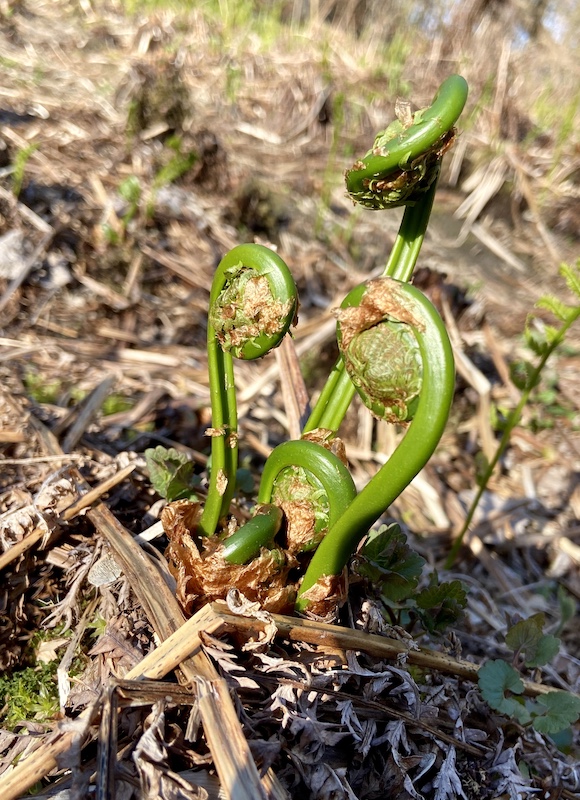
Posts may contain links to products and services I love. I may make a small commission from them, at no extra cost to you. Thank you for supporting my blog.
Ferns do a grand unveiling every spring by unfurling their violin top-shaped shoots into lush green fronds. These fern fiddleheads are one of those choice wild edibles every wild foodie talks effusively about. It’s for good reason as this wild green vegetable is delicious eaten simply or made into delectable recipes.
Fiddleheads emerge in the early spring around the end of April to the middle of May depending on how far north you live. When the first ephemeral wildflowers bloom, the fiddlehead ferns will be doing their thing too. Also, look for wild ramps at this time too.
This post covers how to identify, responsibly harvest, and cook fiddleheads. I include four of my favorite recipes to make delicious fiddlehead dishes. Additionally, find other wild edibles posts in this series. Check out my post on collecting and eating ramps for more information.
I’ve done numerous hikes in New England where I suddenly discover a patch of wild edibles. In the spring I usually carry my wild edible daypack. My foraging daypack contains reusable plastic bags, kitchen scissors, trowel, jackknife, a field guide to wild edibles, a water bottle for drinking water and washing plants, and a pack towel to wipe the dirt off my hands. My go-to field guide is the Peterson Field Guide to Edible Wild Plants.
Identifying Fiddleheads
The forager’s first challenge is to find these wild edibles before they turn their tightly coiled fiddlehead pajamas into their glorious leafy work wardrobe. The second challenge is to choose the correct fiddleheads to collect. All ferns do a rendition of fiddling when they sprout so you might confuse them.
In North America, the ostrich fern is the one you are looking for. It has a distinctive brown paper-like sheath on the fiddlehead when it emerges from the ground. As the fern frond uncoils the brown paper husk flakes away. So it there is no brown papery covering, it’s either not an ostrich fern or it’s an ostrich fern too mature to eat. To double-check your identification of this wild edible, look for a groove on the fern stem that looks like a celery stalk. As with all wild edibles, if you are not sure, don’t eat it.

Related Post -> The Best Paddling Spots in Western Massachusetts
Responsible Harvesting of Fiddleheads
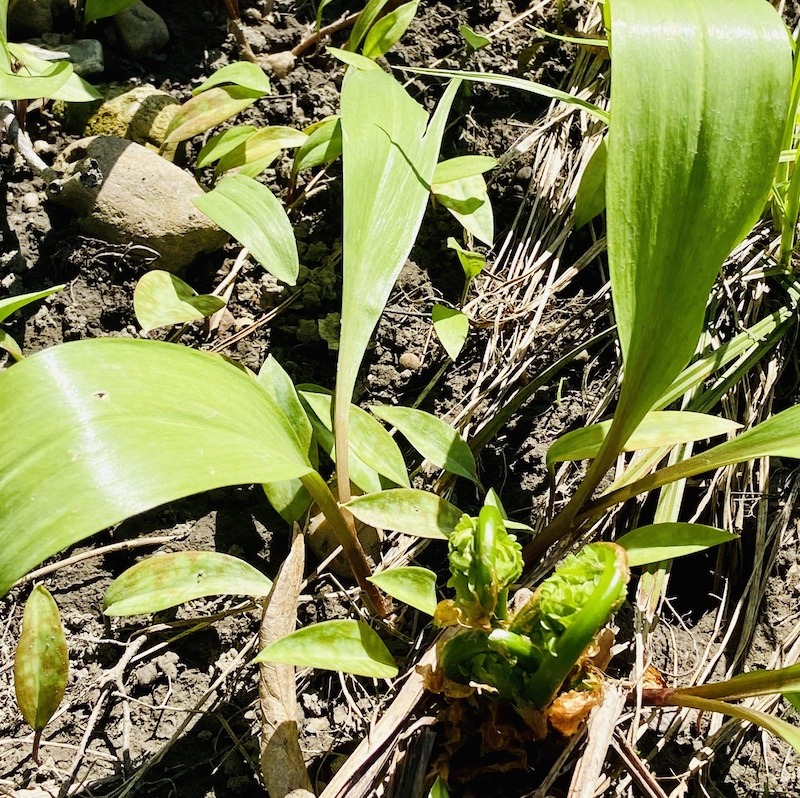
The fertile sandy soil beside waterways is a prime area to find fiddleheads. They can also be found in wet woods and floodplains. It’s common to find other wild edibles such as ramps or wild nettles growing in the fiddlehead patch.
Ostrich ferns grow from last year’s blackish clump that has died back. Each clump can sprout between 2-8 ferns. To sustainably harvest, only take less than half of the fiddleheads in each group. Let the rest mature into beautiful ferns to continue the fern population of the area. Once, on a canoe trip, I watched commercial harvesters work on an island across from my campsite. They picked every single fiddlehead on the property. That summer, when I returned, I was saddened to see only a few random ferns on what was once a lush fern island.
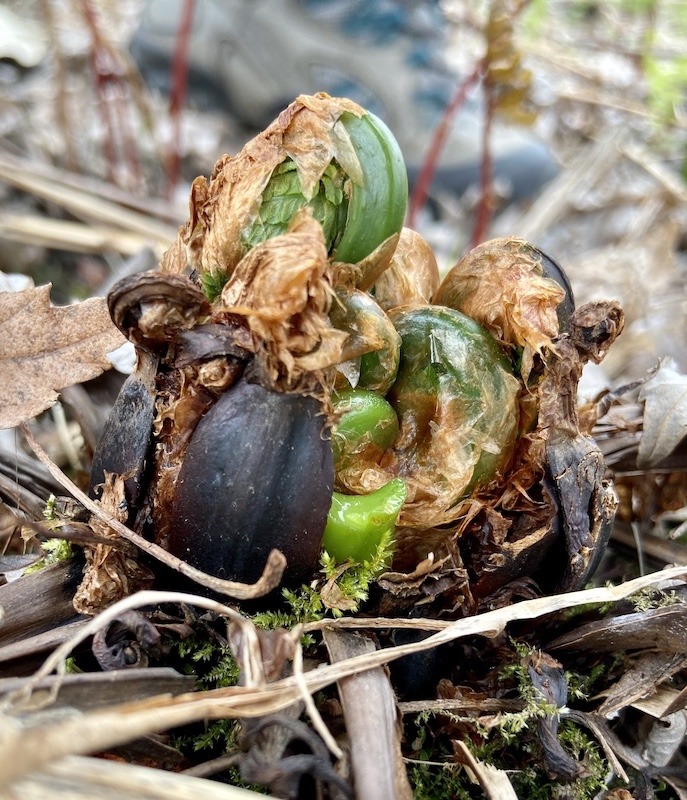
Pick the fiddleheads closest to the ground. Once these wild edibles have started to uncoil they are past their eating prime. Some harvesters pick a part of the stem which is fine, but I like to just get the heads. I try to brush off some of the papery husks with my fingers when I’m picking just to make prepping them easier later on.
Related Post -> Best Hikes in the Holyoke Range
Eating Wild Edibles: Fiddleheads
When I’m camping, I boil the fiddleheads and eat simply with lemon and butter. Freshly picked fiddleheads are one of my favorite wild edibles. When I worked as an outdoor instructor, every spring I would take my outdoor leadership class on an overnight canoe trip in prime fiddlehead territory. Imagine waking in the misty morning on the river to collect the emerging fiddleheads to add to our breakfast eggs. The students soon learned why I insisted on adding a lemon and a stick of butter to their food planning list.
Prepping the fiddleheads
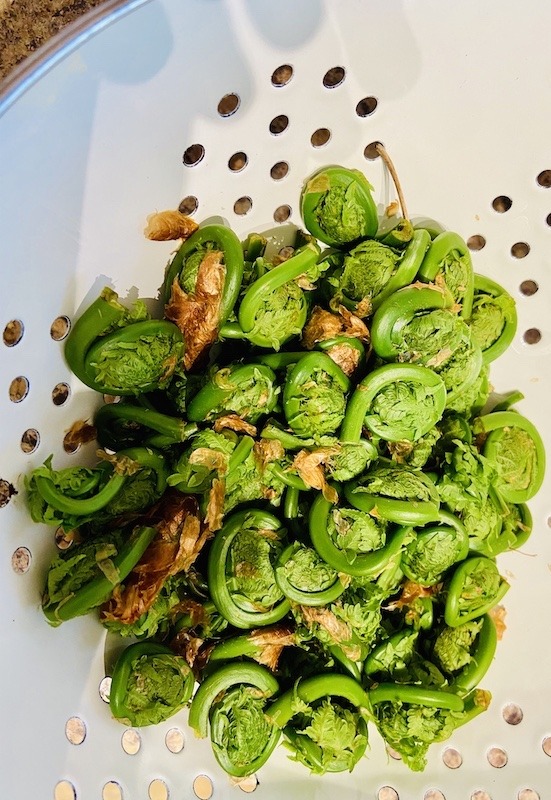
There are many suggested ways to prepare fiddleheads but it’s important that they are cooked before consumption. First, prep the fiddleheads by removing the residual papery husk. I like to do this by hand before rinsing them because the cold water makes the paper stick to them. After removing as much husk as I can, I rinse the fiddleheads well.
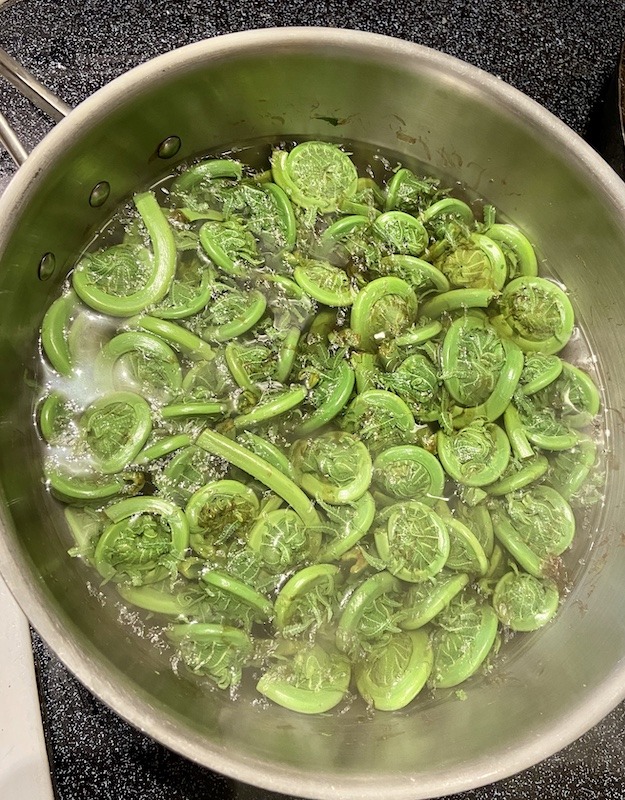
Next, I add my batch of fiddleheads to boiling water and parboil for a couple of minutes until the water turns brown. Parboiling releases the tannins and bitterness from the fiddleheads. Drain the dark water.
What happens next depends on what I’m doing with the fiddleheads. If I’m using them as a cooked vegetable, I boil or steam them until they are tender. You will have blackish water with the first boiling and steaming. Drain and throw away this water, add clean water, and boil or steam again until they are done. Don’t overcook them. They should be firm, not mushy.
If the fiddleheads are to be used in a recipe, they will be further cooked in the preparation of the dish. Therefore, the second boil should be brief. Either way, this two-step process through a change of water has worked well for me to have safe and tasty fiddlehead dishes.
Wild Edibles Recipes: Fiddleheads
Here are four of my favorite wild edible recipes for fiddleheads. Make sure you do the first parboiling of the fiddleheads before proceeding with these recipes. These recipes are very adaptable to change. I don’t even make them the same way every time. A pinch of red pepper here and a dash of sesame oil there and you can change up the recipes.
Pickled Fiddleheads
I confess. I’m a Food Network junkie. I can’t tell you the number of times I’ve heard chefs on Food Network say ” I’m going to make a quick pickle.” Therefore, I’m going to make a quick pickle recipe for fiddleheads.
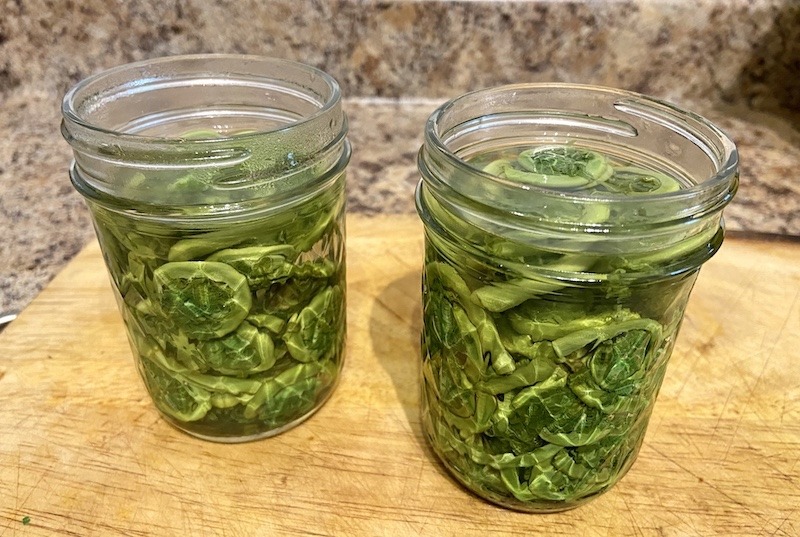
Ingredients:
- Prepped Ostrich fern fiddleheads
- 1 cup vinegar-white, apple cider, or rice vinegar are good
- 1 cup water
- 1-2 teaspoons salt
- 1 tablespoon sugar (or another sweetener such as honey or maple syrup)
Pack the cleaned, parboiled fiddleheads into jars. Boil the last 4 ingredients in a saucepan until the sugar and salt are well dissolved. Pour into the jars covering the fiddleheads. Let the jars cool on the counter, then put the lids on and refrigerate. They can keep in the refrigerator for 2-4 weeks and get better with age. The addition of spices such as dill, mustard seed, cayenne, or garlic cloves will produce unique flavors.
I like to eat pickled fiddleheads on a veggie burger, in whole grain dishes, or in egg or tuna salad. They dress up a charcuterie board with wild edible character.
Beer-battered Fiddleheads
Ok, just about anything fried in oil tastes decadent. Fiddleheads are no exception. They are a yummy addition to any backyard party. Serve them with ramp aioli or your favorite dipping sauce.
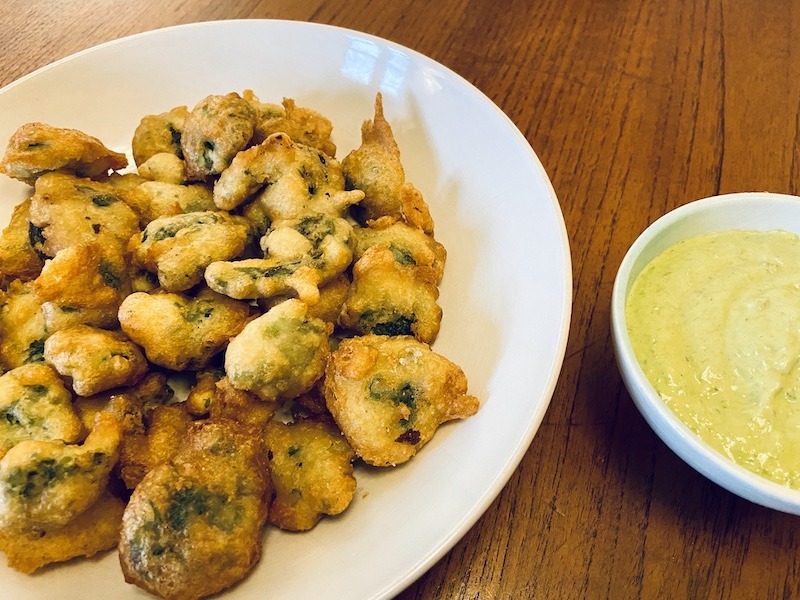
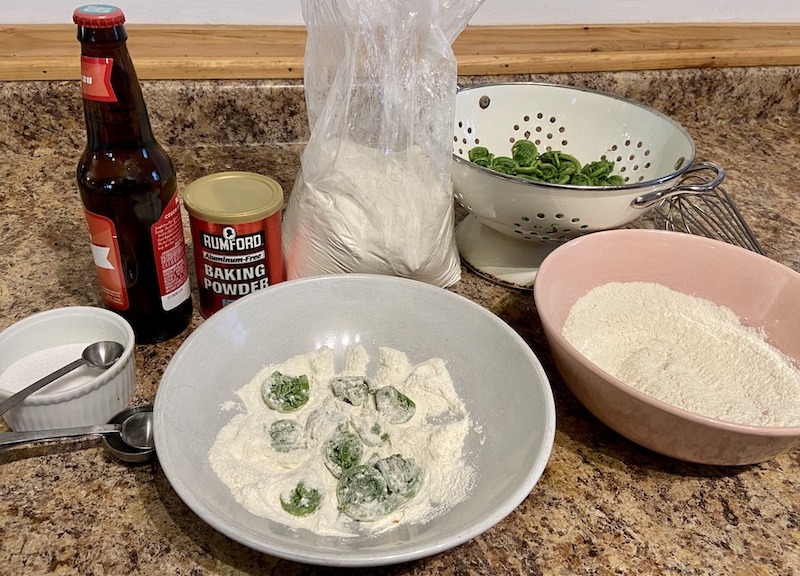
The beer batter recipe is easy.
- 1 cup flour
- 1 teaspoon baking powder
- 12-ounce beer
- 1 teaspoon salt
There are opinions about what beer is best to use. However, just use the beer that is leftover in your refrigerator because no one likes it. You are after the bubbles in the beer not the taste. Mix the dry ingredients and quickly whisk in the beer. Don’t overmix. Dredge the fiddleheads that have been patted dry in some flour. Then dip in the beer batter and deep fry in oil in batches. The temperature of the oil should be in the range of 350-375 degrees. Remove with a slotted spoon when they are golden brown and drain on paper towels. Salt while hot and serve.
Fiddlehead Fried Rice

My family thinks I make wonderful fried rice. I’ve certainly had lots of practice. When my daughter arrived from China at age 4, fried rice was the only thing she would eat. So for the next year, I made fried rice every morning until she graduated to other breakfast foods. It’s a super way to use up leftover rice and random vegetables in the crisper of the refrigerator. It’s particularly good with fiddleheads.
Ingredients:
- 1 cup prepped Ostrich fern fiddleheads
- 2-4 cups leftover rice–whatever you have
- Chopped vegetables of your choice
- 2-3 tablespoons oil such as canola or sunflower
- 2-3 cloves garlic minced
- 1 teaspoon peeled ginger minced
- Soy sauce or tamari sauce
- 1 or 2 eggs
Prep the fiddleheads as detailed above and chop some vegetables. I like to use shredded carrots, chopped celery or bok choy, and red pepper. Broccoli, asparagus, or other Chinese vegetables are also good. Just don’t overpower the fiddleheads so they can be the star of the dish.
In a wok or cast iron pan, heat 2-3 Tbsp. oil. Add 2-3 cloves minced garlic and about 1 tbsp. minced ginger and stir fry. Add the rest of the vegetables and fiddleheads before the garlic browns. Stir fry them briefly and add the leftover rice. Let the rice crisp a little on the bottom of the pan so don’t stir it much at first. Add 1 Tbsp. of soy sauce or tamari then start moving the rice around to heat through. The last step is to make a well in the rice on the side of the pan, and crack an egg or two into that space. Scramble the egg mixture well and continue to stir it until cooked. Once the egg is cooked, mix it into the rice. Add more soy sauce or salt and pepper to taste.
If you want a little more protein, add cooked shrimp, chicken, or tofu when frying the rice.
Fiddlehead Soup
If you like asparagus or any other green vegetable soup, you will enjoy fiddlehead soup. It can be made as a creamy soup or just a hearty green broth soup.
Ingredients:
- 2 cups Ostrich fern fiddleheads-washed well, parboiled, and drained.
- 1 medium onion chopped
- 2-3 cloves garlic minced
- 2 fist-sized potatoes
- 2 tablespoons butter (or oil for a non-dairy version)
- 4 cups vegetable or chicken stock
- 1 cup heavy cream (optional)
- Salt and pepper to taste
Start by parboiling the fiddleheads to remove the tannins, drain, and set aside. Melt 2 Tbsps. butter in a soup pot. Add chopped onion and sauté until tender. Add the minced garlic and sauté. Put in the potatoes, fiddleheads, and salt then continue to cook for 2-3 minutes, stirring regularly. Add the stock and bring to a boil. Simmer until the potatoes are tender.
Using a regular blender or an immersion blender, puree the soup until it is the desired consistency. Return to the pot, and add salt and pepper to taste. If you want the soup creamy, add heavy cream (or almond milk for a non-dairy alternative) and heat to serving temperature.
Serve garnished with cooked fiddleheads. Cayenne is a tasty addition to spice up this soup. For the creamy version, a dash of nutmeg brings out the flavor nicely.
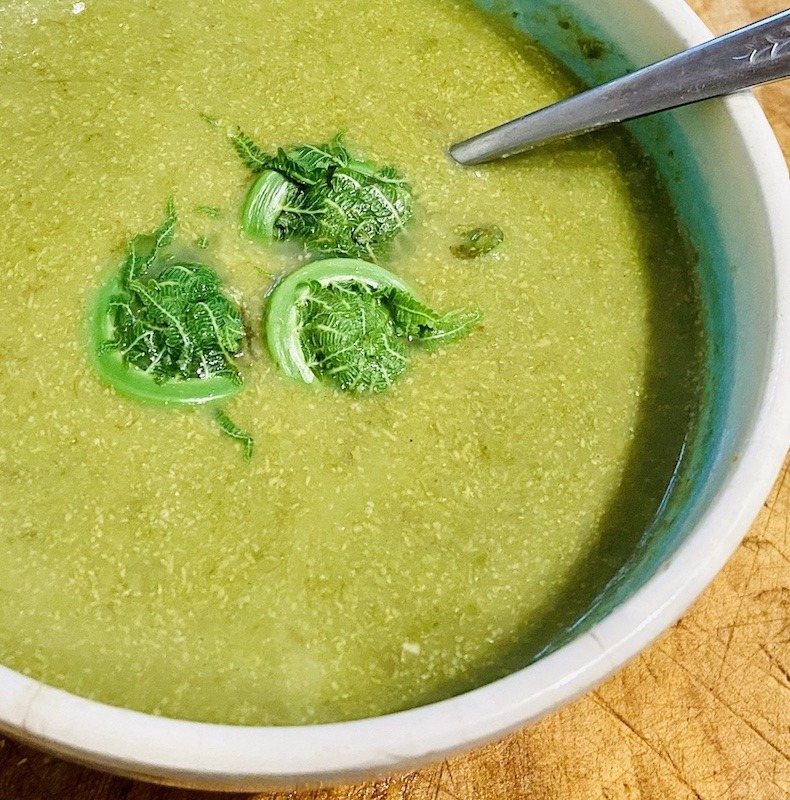
Some final words on wild edibles and fiddleheads
Fiddleheads are an amazing source of vitamins A and C, plus niacin and potassium, and taste good too. But they are a blink and you will miss them wild edible. Don’t wait too long to go fiddlin’ or you will arrive at a patch of gloriously unfurled ferns and will need to wait until next year to try these recipes.
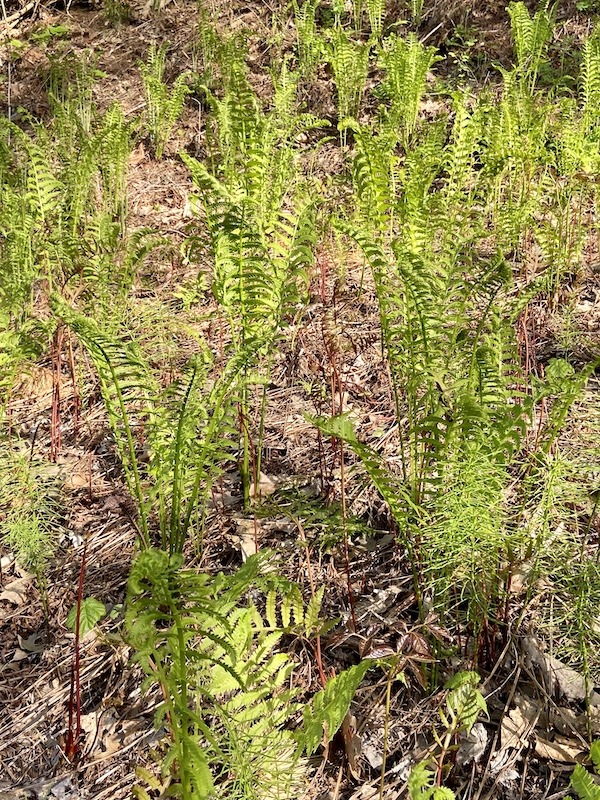
If you are lucky enough to find a fertile patch of Ostrich ferns, enjoy a wild edible food source for years to come. Happy fiddlin’!
Save for later. Pin it!
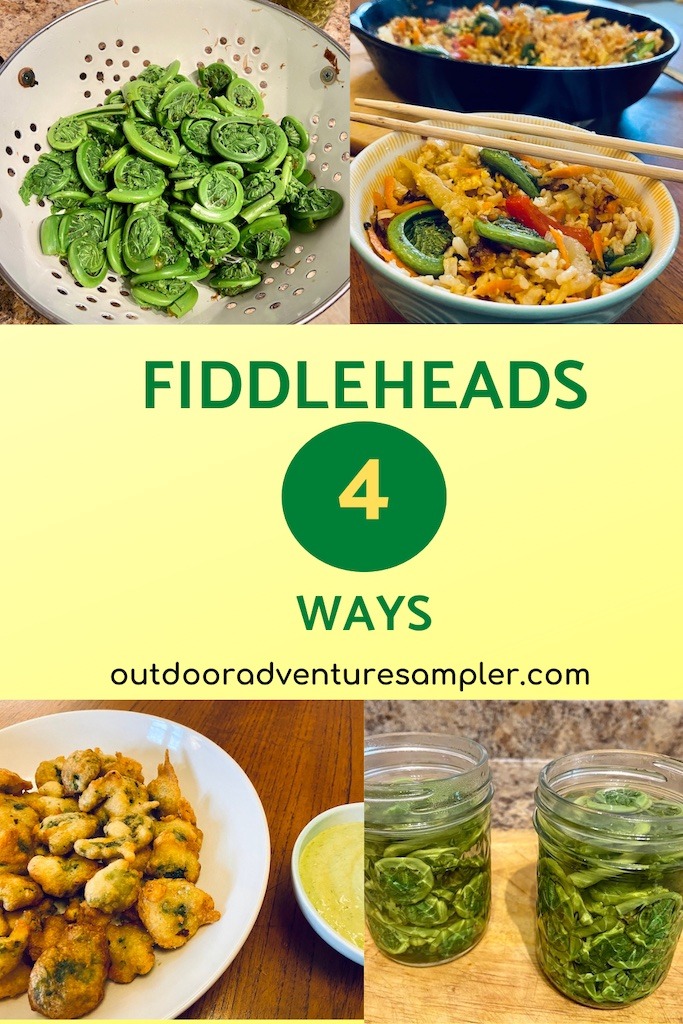

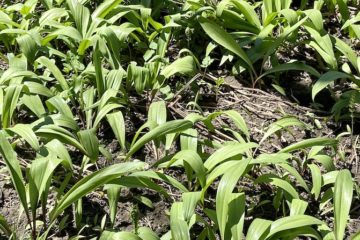
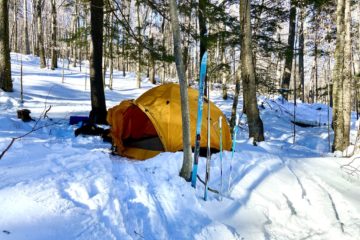

15 Comments
Tranquil Trekker · May 19, 2020 at 9:53 am
This is cool! I love the idea of being able to eat the natural food sources we found ourselves surrounded by. Great post, thanks for the info!
Tara · May 19, 2020 at 10:40 am
I love fiddleheads! I always have trouble getting to them at the right time, so I planted a few in my back yard. After 10 years, we’ve got a nice healthy patch. If they’re still young enough, I want to make the beer-battered ones tonight! Never tried that before!
Karen · May 19, 2020 at 8:54 pm
I hope you found some. The beer-battered fiddleheads don’t last long in my house. I’ve been serving them with leftover ramp aioli and they seem to disappear when I turn my back.
Farrah · May 19, 2020 at 3:48 pm
This is going to sound super sad, but I only knew what fiddleheads were because I recently started playing a co-op Stardew Valley game with my best friend and we had some of these! 😛 It’s great to learn more about them–they look so cool! I’d love to try them in fried rice!
Karen · May 19, 2020 at 8:55 pm
I’m happy fiddleheads made it into a video game. So cool. Yes, the fried rice with fiddleheads is yummy.
Susan · May 19, 2020 at 8:32 pm
Ha ha – I know what you mean about “making a quick pickle” 🙂 Seriously drooling over the beer battered fiddleheads with ramp aioli!!!
Karen · May 19, 2020 at 8:57 pm
The beer-battered fiddleheads disappear as fast as I make them. So good with the ramp aioli.
Josy A · May 20, 2020 at 5:35 pm
I reeeeally want to try these. I always seem to think of it once it is too late. I did notice signs in one of our local provincial parks asking people not to pick the fiddleheads, so possibly people were taking too many here.
The beer battered fiddleheads sounds fantastic – as does that fried rice. Yum!!
Amelia · March 28, 2024 at 4:45 pm
The fried fiddleheads are my Spring favorite of yours!!! Xxox!’
Karen · March 31, 2024 at 10:19 am
Beer battered fiddleheads with ramp aioli are divine! I’m missing fiddlehead season this year while travelling to my great chagrin.
karl · April 22, 2024 at 5:22 pm
i found some fiddleheads that have a white fuzzy furr on them…i was wondering if they are safe to eat? i have heard that 99% of ferns are edible.
Karen · April 22, 2024 at 9:07 pm
I advise not eating anything you have not positively identified. There are some woodland ferns with fuzz that are Edible but not particularly flavorful. But I don’t know the one that you are referring to so I would be careful. I always stick with the ostrich fern for eating.
Travel Outside Locally with the 30 Day Outdoor Challenge · April 18, 2021 at 10:53 am
[…] wild edibles. My spring wild edibles article introduces some of my favorites. Plus these posts on fiddleheads and ramps or wild garlic will help you identify and cook these all-stars of the wild edible world. […]
Ultimate Guide to Wild Edibles: Wild Ramps - Outdoor Adventure Sampler · November 23, 2022 at 11:15 am
[…] Related post -> Ultimate Guide to Wild Edibles: Fiddleheads […]
A Guide to Gourmet Meals in the Great Outdoors: Mastering Wilderness Cooking - holisticfood.com · April 19, 2024 at 6:29 pm
[…] before you go snatching up every fiddlehead in sight, remember the forager’s golden rule: to sustainably harvest, only take less than half of the fiddleheads in each group. Let the rest mature into beautiful […]